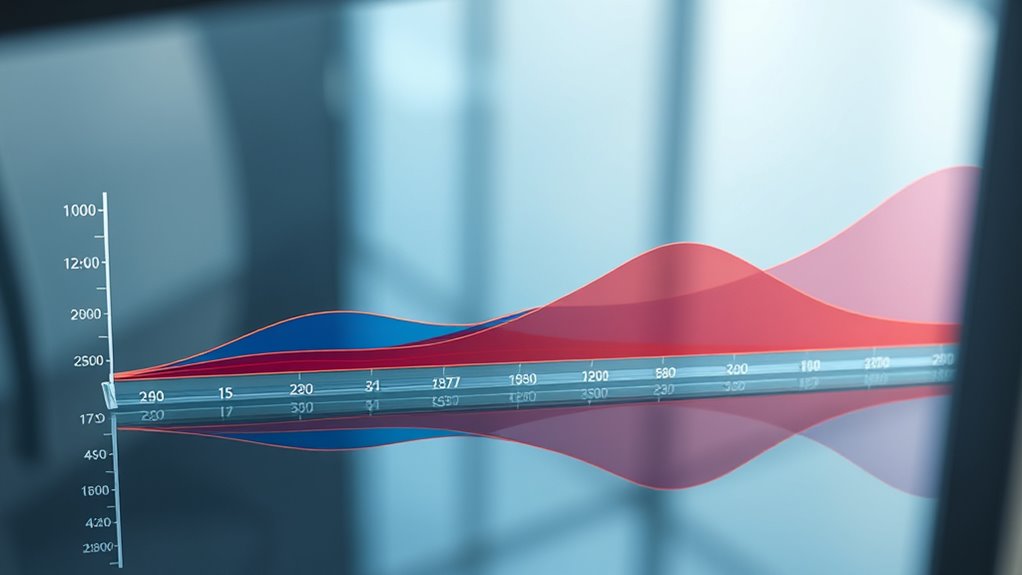When you start paying your mortgage, most of your payment goes toward interest because you’re paying interest on a larger remaining balance. As you continue making payments, the balance decreases, and less interest accrues. More of each payment then goes toward reducing the principal. This shift helps you build equity faster over time. To understand how your payments evolve and how interest impacts your loan, keep exploring the details behind amortization schedules.
Key Takeaways
- Early mortgage payments are mostly interest, with a small portion reducing the principal balance.
- Interest is calculated on the remaining loan balance, decreasing as the principal is paid down.
- Over time, the interest portion of each payment declines while the principal portion increases.
- As the loan progresses, less interest accrues, allowing more of each payment to go toward reducing debt.
- The amortization schedule visually shows how interest costs decrease and equity builds over the loan term.

Have you ever wondered how the interest on your mortgage changes as you pay it off? The way interest is calculated and paid over time can seem complicated, but understanding the payment schedule and amortization schedule can make it clearer. When you first take out a mortgage, your lender provides you with a payment schedule that outlines exactly how much you’ll pay each month. This schedule divides your total monthly payment into two parts: principal and interest. Early in the loan term, a larger portion of your payment goes toward interest, with only a small amount reducing the principal. As you continue making payments, this balance shifts, and more of your money gets applied to the principal.
Understanding your mortgage’s payment and amortization schedules reveals how interest decreases as you pay down principal.
The amortization schedule is fundamentally a detailed roadmap of this process. It shows how each payment affects your loan balance over the entire loan term. At the beginning, the schedule indicates that a significant part of your monthly payment is interest. This is because the interest is calculated based on the outstanding balance, which is highest at the start. As you make payments, the remaining balance decreases, and so does the amount of interest owed on the next payment. Over time, you’ll notice that your payments are gradually shifting from mostly interest to mostly principal. This transition is a key feature of an amortization schedule, and it’s what allows your mortgage to be paid off steadily over the agreed term.
The payment schedule is designed to guarantee consistent payments, but the composition of each payment changes throughout the life of the loan. Early payments are heavily weighted toward interest, which means you’re paying a lot of interest upfront. However, as the loan progresses, the interest portion shrinks, and more of each payment goes directly toward reducing your principal. This change is crucial because it affects how quickly you build equity in your home. Understanding your amortization schedule can help you see how your payments are reducing your debt and how interest costs decline over time.
Knowing how your interest works over time empowers you to make informed decisions about your mortgage. You might consider making extra payments early on to reduce interest costs since more of your payment is going toward interest at the start. By understanding your payment schedule and reading your amortization schedule, you can better plan your financial future, pay off your mortgage faster, and save money on interest in the long run.
Frequently Asked Questions
Can I Pay off My Mortgage Early Without Penalties?
Yes, you can pay off your mortgage early without penalties if your loan allows prepayment strategies. Many lenders offer options to make extra payments or pay off the loan ahead of schedule. Just check your loan agreement for prepayment penalties or restrictions. Paying early can save you money on interest and may even qualify you for loan forgiveness programs in some cases. Always confirm with your lender before proceeding.
How Does Refinancing Affect My Mortgage Interest?
Think of refinancing as changing your boat’s sail to catch better winds. When you refinance, you can benefit from interest rate changes, potentially lowering your payments. Refinancing benefits include securing a lower interest rate, which reduces the total interest paid over time. However, be aware that changing your mortgage terms might reset your interest calculations, so weigh the long-term savings against any new costs involved.
What Are the Tax Implications of Mortgage Interest?
When you pay mortgage interest, you may qualify for tax deductions that reduce your taxable income, but you can’t deduct property tax or mortgage insurance premiums together with interest. Keep in mind, mortgage interest deductibility is limited if your mortgage exceeds certain amounts. You should track these expenses carefully and consult a tax professional to maximize your deductions and understand how property tax and mortgage insurance impact your overall tax situation.
How Do Adjustable-Rate Mortgages Differ in Interest Over Time?
Imagine riding a roller coaster—your interest rate in an adjustable-rate mortgage (ARM) rises and falls with market fluctuations. You’ll experience interest rate fluctuations during your loan term, with payment adjustment schedules set at specific intervals, like every year or every few years. This means your monthly payments can increase or decrease, giving you flexibility but also unpredictability. It’s a dynamic way to finance, but stay prepared for changes.
Does Making Extra Payments Reduce Total Interest Paid?
Yes, making extra payments reduces your total interest paid. Prepayment strategies, like paying more than your scheduled amount, speed up interest amortization, meaning you pay down the principal faster. This decreases the amount of interest accruing over time and shortens your loan term. By consistently applying extra payments, you can save thousands in interest and become mortgage-free sooner, making it a smart financial move.
Conclusion
Understanding how mortgage interest works over time is like riding a wave—your payments start high, then gradually ebb as you chip away at the principal. With each payment, you’re steering your ship closer to calm waters, saving you money in the long run. Keep your eyes on the horizon, stay consistent, and watch your debt shrink like a star fading at dawn. Your steady course turns the tide in your favor, leading you home.









